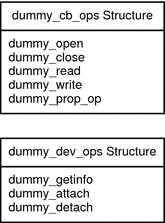Overview of the Template Driver Example
-
Create a directory where you can develop your driver and open a new text file named dummy.c.
-
Write the entry points for loadable module configuration: _init(9E), _info(9E), and _fini(9E).
-
Write the entry points for autoconfiguration: attach(9E), detach(9E), getinfo(9E), and prop_op(9E).
-
Write the entry points for user context: open(9E), close(9E), read(9E), and write(9E).
-
Define the data structures: the character and block operations structure cb_ops(9S), the device operations structure dev_ops(9S), and the module linkage structures modldrv(9S) and modlinkage(9S).
-
Create the driver configuration file dummy.conf.
-
Build and install the driver.
-
Test the driver by loading the driver, reading from and writing to the device node, and unloading the driver.
This example guides you through the following steps:
The entry points that are to be created in this example are shown in the following diagram.
Figure 2–1 Entry Points for the dummy Example

- © 2010, Oracle Corporation and/or its affiliates
